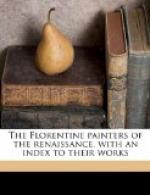Giotto’s paintings, on the contrary, have not only as much power of appealing to the tactile imagination as is possessed by the objects represented—human figures in particular—but actually more, with the necessary result that to his contemporaries they conveyed a keener sense of reality, of life-likeness than the objects themselves! We whose current knowledge of anatomy is greater, who expect more articulation and suppleness in the human figure, who, in short, see much less naively now than Giotto’s contemporaries, no longer find his paintings more than life-like; but we still feel them to be intensely real in the sense that they still powerfully appeal to our tactile imagination, thereby compelling us, as do all things that stimulate our sense of touch while they present themselves to our eyes, to take their existence for granted. And it is only when we can take for granted the existence of the object painted that it can begin to give us pleasure that is genuinely artistic, as separated from the interest we feel in symbols.
[Page heading: Analysis of enjoyment of painting]
At the risk of seeming to wander off into the boundless domain of aesthetics, we must stop at this point for a moment to make sure that we are of one mind regarding the meaning of the phrase “artistic pleasure,” in so far at least as it is used in connection with painting.
What is the point at which ordinary pleasures pass over into the specific pleasures derived from each one of the arts? Our judgment about the merits of any given work of art depends to a large extent upon our answer to this question. Those who have not yet differentiated the specific pleasures of the art of painting from the pleasures they derive from the art of literature, will be likely to fall into the error of judging the picture by its dramatic presentation of a situation or its rendering of character; will, in short, demand of the painting that it shall be in the first place a good illustration. Those others who seek in painting what is usually sought in music, the communication of a pleasurable state of emotion, will prefer pictures which suggest pleasant associations, nice people, refined amusements, agreeable landscapes. In many cases this lack of clearness is of comparatively slight importance, the given picture containing all these pleasure-giving elements in addition to the qualities peculiar to the art of painting. But in the case of the Florentines, the distinction is of vital consequence, for they have been the artists in Europe who have most resolutely set themselves to work upon the specific problems of the art of figure-painting, and have neglected, more than any other school, to call to their aid the secondary pleasures of association. With them the issue is clear. If we wish to appreciate their merit, we are forced to disregard the desire for pretty or agreeable types, dramatically interpreted situations,




